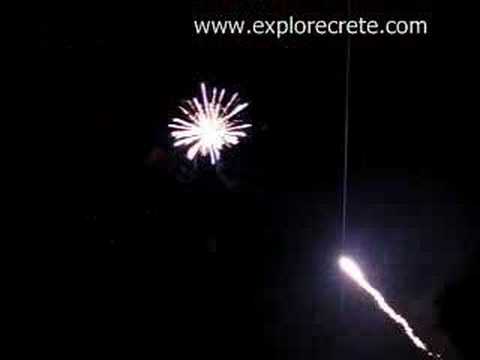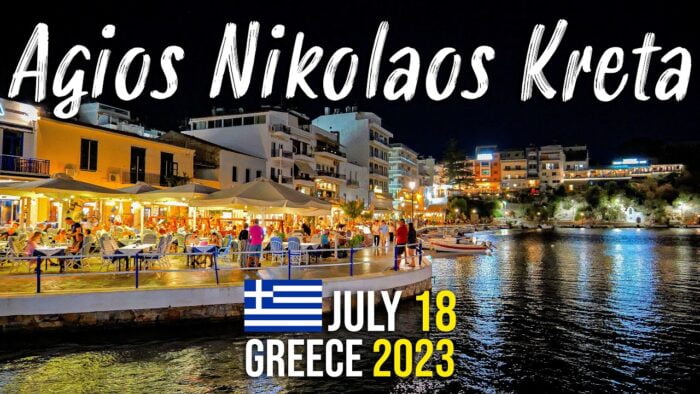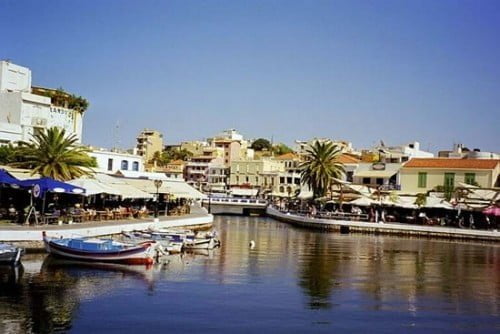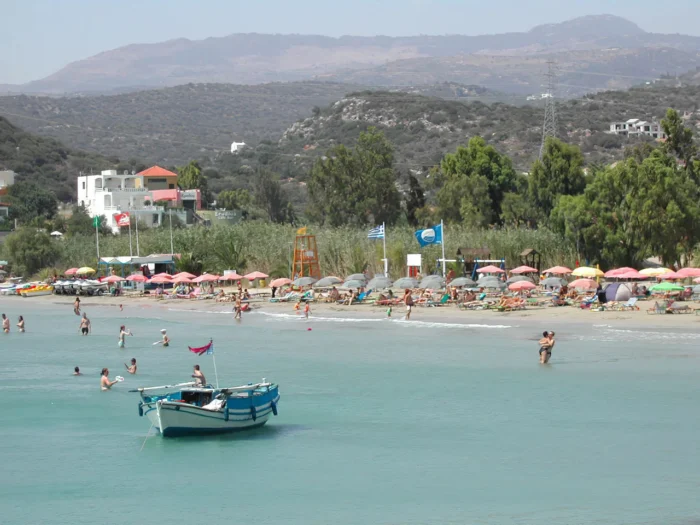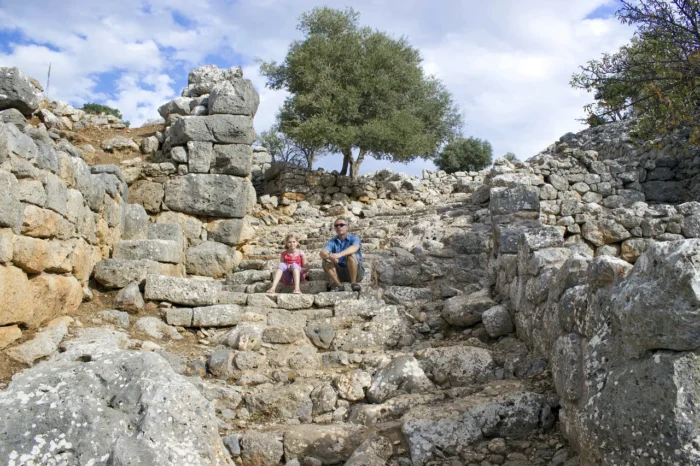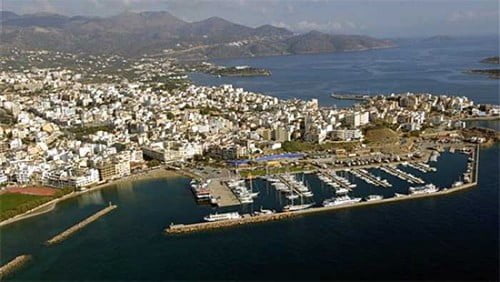Milatos – Anogia – Latsida – Voulismeni – Vrahassi
The hidden Lassithi
We set out early on a fine day, hot but with the promise of a breeze. My companion, Yannis (of www.explorecrete.com) had at least some idea of where we would be heading. With the sun rising before us we headed east from Heraklion through familiar terrain, the main coast road that takes you past Chersonisos and Malia, and then on through Lassithi.
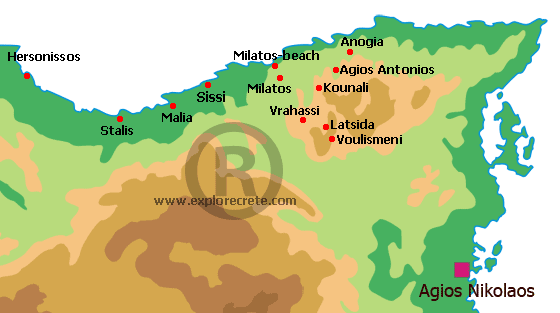
Turning off the road just past Malia, however, led us to spend one day in a countryside that allows the visitor a glimpse of a different Crete . There are treasures to be found in the foothills and villages behind the coastal resorts, and, knowing that there is still a severe lack of information available to the average visitor, your intrepid explorers will try to point out a few of the area’s hidden charms.
The trip we took, around the area by car, can easily be done by scooter or quad, from Sissi or Milatos, or by car from Agios Nikolaos, the capital of Lassithi, and will open the eyes to what Crete actually is, if you want to see it, all the year round. This was a tour for those who want to see under the surface, and, in my imagination, I can see this as a small journey of discovery for anyone who cares to open their eyes.
Sissi
We turned northeast just after Malia, stopping first in Sissi, a pretty enough village, dedicated to enticing summer visitors to its shoreline apartments, shops and eating-houses. Sissi cannot compete with larger resorts in terms of beaches and gaudy attractions, but does well to preserve the charm of its sea channel, an inlet of water that forms a harbour reminiscent of a river mouth, with space for boats as well as swimming.
People jumping into the sea from the harbour sides, and toasting themselves on surrounding oval shaped rocks, seemed content enough in this calm place. I am assured that the beach in front of an adjacent hotel, “Kalimera Kriti”, is just fine, with plenty of soft sand. We will return to Sissi on the way back, but now Yannis was keen to press on. We didn’t know exactly what we would find, but here in Crete , its best to allow time. In this place, there is always, but always, the unexpected.
Milatos
Milatos, a few kilometres from Sissi, is also fine, like its neighbour, with some beach and plenty of accommodation. The coast around here is quite rocky, so, especially if you have kids, make sure you can find the more sandy beaches, like the one in the fishing port at Milatos. There is a cave above Milatos that is well worth a look, and easy to get to, but buy a cheap torch in town before you go.
My thoughts, as we drove up, past the cave and away from Milatos, were of how much of this trip might be off-putting to the first-time traveller, and how much could be recommended as an essential diversion from the heady pleasures of the coast.
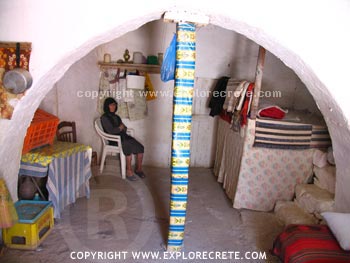
Even if a visitor to the island is first and foremost a sun-seeking hedonist, there must be, even in the space of a week, one day when other senses need to be brought to play. The winding road we were taking quickly brought us to Kounali, where estate agents’ signs in English show evidence of an influx of Northern Europeans.
It is too soon to know how many will settle in these villages, but it is a safe bet that village life will be affected. There is always change, even if it is very slow, and we may just be seeing the start of a transformation in the character of this island’s hinterland.
Agios Antonios
We pass through Tsampi and stop briefly in Agios Antonios , where an elderly woman speaks to us from her home about the village. This village would have been well populated at one time, like many others, but now it awaits the next chapter in its story.
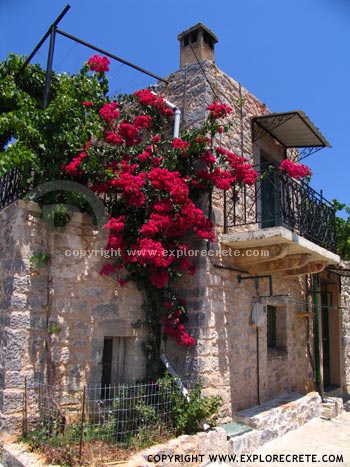
Perhaps young Greeks will return to take care of these strong Cretan houses, many now standing empty. More likely, foreigners from Europe , east and west, will make their mark. The future is far from certain, but there is beauty here, and there is hope.
Anogia
Past Agios Antonios, we arrive at Anogia, truly off the beaten track. This is not the famous Anogia on the northern slope of Psiloritis outside Rethymnon, but a small village, once proud of its numbers, 350 voters, many more people if we include family members, lived in these close knit villages, now down to nine souls in residence.
It’s around 5 to 7 km from Milatos, on a bendy road. The village is very small and most houses are derelict. We spotted very few houses that looked inhabited and a couple of cars parked in the narrow roads. We entered the village and kept driving straight, ignoring the sign “To the Beach, 4 Km”.
The road in the village proved to be a dead end, so we parked the car and we walked past the last houses. 50 m later we were rewarded with an amazing view of the Cretan sea from high above. On our left we could see the cement road that went past Anogia to the rocky coast beneath us.

Blooming thyme was all over and bees buzzed around carrying the nectar to their beehives. The unique shades of blue of the Mediterranean sea was overwhelming and, once again, we felt the joy of just sitting and admiring the beauty of the Cretan nature.
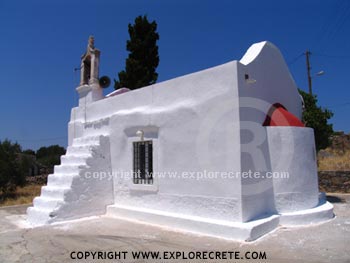
We returned back to the village and stopped in front if an elegant whitewashed church. An elderly couple, who heard the unexpected noise of a car motor in their village, were willing to open the small and very pretty chapel for us, explaining that tomorrow would be the day of the church’s patron, Profitis Ilias and a celebration in their village. I liked this couple, she finishing his sentences, he superfluously reminding her that he was boss, as they argued, in their way.
Profitis Ilias (Prophet Elias) was a patient man who lived by the sea. Not quite a saint, he is still revered as a teacher. The story goes that he came from a fishing village and wanted to do good beyond his known world, somewhere that had not known the life that he was accustomed to, the life of the sea. So, he set off from his home, carrying an oar across his shoulder. Days walking inland were spent asking ‘Do you know what this is?’, to be met with ‘Yes, it’s an oar. Are you nuts?’ Eventually he was in the mountains, far, far away. On one high peak he reached a place where the oar was not recognised and there he founded a church. Churches of Profitis Ilias are now usually found on the highest peaks. Coincidentally, early pizza ovens began appearing at the same time.
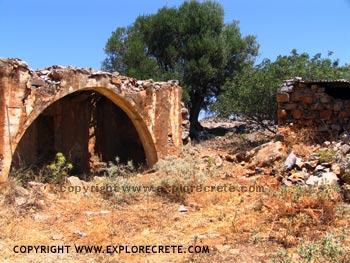
We walked around this village of Anogia , and I will unreservedly recommend that you do the same. The village may not be marked on every map, but a decent guide should at least show the church of old Profitis Ilias, and locals will point the way. It is so close to Malia, to Sissi and Milatos, and yet a world away. You will find a small Kafenio that cooks omelette or whatever is fresh on the day. The air is cooler here, and there are fine views to the sea. We stopped at the kafenio to ask about the beach which, according to the sign, is 4 km past Anogia. They informed us that there is a small beach but not a sandy one. The road down to it is concrete-surfaced and safe for every brave driver. The family who owned the kafenio, happened to have their lunch at that time and they invited us to share it with them, a generous offer we had to decline, or at least have a coffee or refreshment. It is always a warm surprise, no matter how often I come across it, to experience the hospitality of people in these places, where such ‘filoxenia’ is normal and unforced. Never take it for granted, but be thankful it still exists. This is Crete .
Back to our journey, and fromAnogia we take the road back to Agios Antonios, Tsampi and Kounali, and then we continue to Latsida and Voulismeni, a couple of km before Neapolis, the largest town in thearea.
Latsida and Voulismeni
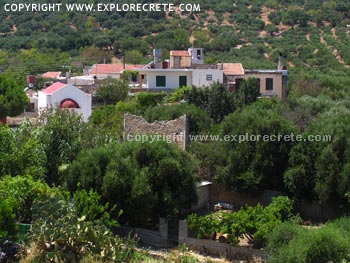
Latsida and Voulismeni are both charming villages and their inhabitants are warm toward those who make an effort to stop and appreciate the surroundings. Tourism has touched these places, but not so much that lives are changed, at least not yet. In Latsida there are several kafenia (plural of Kafenio) and some enticing taverns. In both villages there are pretty side streets in which to stroll and explore.
Past Voulismeni we turn right and follow the signs and the cement-surfaced road to Panagia Vigliotissa (Virgin Mary Vigliotissa). About 1,5 km further we find what is reported to be the site of a Byzantine monastery destroyed by the Turkish army. There is a well-preserved church here, but we find no traces of the monks’ cells mentioned in a local guidebook. There is, however, an underground spring, the well covered by a structure that bears a relief of a head that is surely ancient. Fruit trees and natural shelter surround the church that stands in beautifully tended gardens. It is a great place to stop, eat a picnic, watch the butterflies and perhaps take a short siesta under the trees. This place is another small treasure.
Fraro Monastery
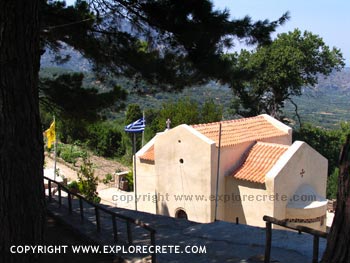
We take the same road back and look for a right turn (dirt track) and a wooden sign pointing to Fraro and the ruins of a Franciscan monastery, which dates back to, possibly, the 13 th Century . This was a moment to remember for me, as we trod this land that had been so important long ago. The walls of the church are thick stone, like the dry-stone walls around, in various states of collapse, but still unmistakably a church. One long room has survived almost entirely, providing a glimpse back in time. It is cool inside, with an atmosphere of calm where once such devotion was offered. Apart from the sound of cicadas, it is silent. Outside, an arch remains to mark the entrance and here and there we can see that stone has been sculpted into decorative fluting, bordering doorways andwindows. I don’t have religious leanings, but cannot help but feel respect inside such places.
Back in Time – The Venetian Period 1204-1669
With the capture of Constantinople with the Fourth Crusade, the Byzantine Empire was divided. Crete was given to Boniface of Monferat, who sold the island to Venice , in 1204. The Venetians kept Handakas (Heraklion) as the capital and built castles in different parts in the island.
The Greek bishop was sent away and the Latin bishops were established, but without annoying the lower Orthodox clergy and religion. Many Orthodox churches and chapels were built, that can be visited today throughout the island.
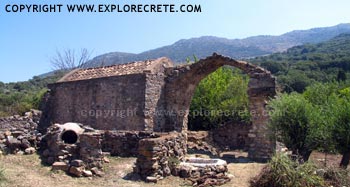
The earth was taken from the people and was given to Venetian knights, with the former owners becoming slaves. Taxes and forced labour must have made life almost unbearable. The Cretan people with their independent character could not accept Venetian occupation, and for many years continuous uprisings brought hard reprisals.
It was during the beginning of this period (13 th Century) that the Franciscan Monks came to Crete in search of places to build a monastery and spread the word of Christ according to the Roman Catholic Church.
The above-mentioned Franciscan monastery at Fraro, is believed to have been built during this time. One of the monks of the monastery, the Cretan Philip Philargos, became Pope Alexander 5th. Alexander V lasted in the position from 1409 to 1410. He is thought to have been a good man, having tried to heal the schisms, and he may well have been poisoned for his trouble.
Vrahassi
We leave here to return to Voulismeni, driving slowly, especially near the villages. Two km past Latsida we turn left (no road sign) to Vrahassi. Vrahassi is a village of a few hundred people, typical of many around, but it has some interesting features, and the traditional Cretan architecture is well preserved here, which makes it highly recommended for a visit.
The main square (platia in Greek) of Vrahassi sits close to the road and has seating at several taverns and kafeneia (cafes), plus a view into the valley. One tavern in particular caught my eye, well cared for and draped in greenery.
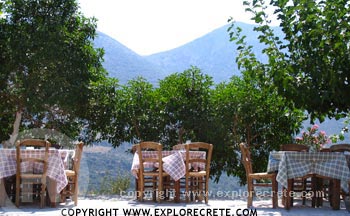
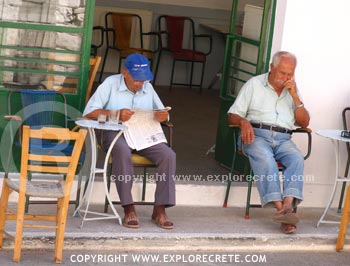
The second square is up a hill, and features an elderly platanos, a plane-tree, that gives good shade. We both found this square a little too enclosed, however, and not the tranquil shelter we had hoped for. On a hot day, you need to be where the breezes can reach you.
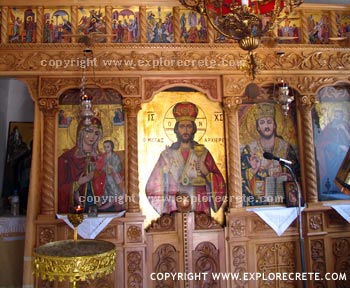
In Vrahassi there is much building going on, mostly, it seems, restoration work on some fine traditional houses. Near to Vrahassi, there is the old monastery of Agios Georgios Vrahassiotis (Saint George of Vrahassi). It is considered a monument of archaeological importance and restoration has been continuous over recent years. Today the monastery is closed to the publicbecause of the theft of part of the church’s carved chancel screen, “templo” in Greek.
Templo (iconostasis) in Orthodox churches is what separates the priest preparing the sacraments at the altar from the congregation. Templa (plural of templo) are often the most beautiful feature of Eastern churches, as the priest steps from behind the central curtain to stand in front of the templo, which will be further decorated with icons and votive offerings.
We leave Vrahassi and we follow the small road running parallel to the highway, inside the gorge of Saint George Selinari, and are rewarded with magnificent rock walls, scenery that needs no fanfare, as it is a monument to, and a reminder of, the quiet strength of the people who have farmed and built homes out of this landscape. It is hard and dry here, like the people, and like them it offers moments of softness and shelter.
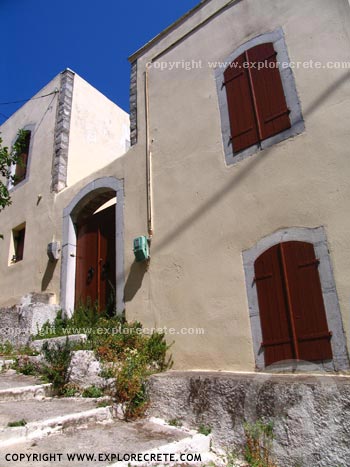
There have been steps taken to preserve the wildlife of this peaceful gorge, including the Griffon Vulture, which can be seen, if you are extremely lucky, returning to roost on the eastern slopes. Hunting here has been banned, thankfully.
As we continued back to Sissi , we talked about what changes may be awaiting these villages. Estate Agents spring up like mushrooms and will continue to sell Crete by the metre. Of course, in a place like Sissi or Milatos, newcomers will be absorbed, hopefully bringing new life and ideas to these communities. Away from the coast, however, it remains to be seen how the Northern European influx will impact on life here. Vrahassi will have its share of foreign home-owners, and it would be good to find out the views of local people about this phenomenon. What are the benefits? Will the newcomers continue to be welcome? House and land prices continue to rise in a country that is quite poor, especially now that coastal tourism is not so profitable. This is a debate that I am sure will continue, on this website and elsewhere.
We finished our day, wisely, eating excellent fresh fish in Sissi, in a nice tavern overlooking the blue seawater river that cuts into the village. Profitis Ilias must have missed this taste after turning away from the sea. Tired but happy, we drove back to Heraklion, through Malia, as evening fell. We had taken nothing but a little knowledge, a few photographs and some good memories from our day in the country, which is as it should be.
Article by Louis Tracy and Yannis Samatas – Copyright www.explorecrete.com
© explorecrete.com All Rights Reserved. Reproduction or copying without permission is prohibited.


